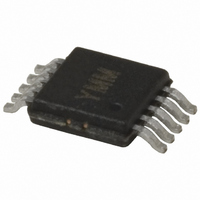MIC2204BMM Micrel Inc, MIC2204BMM Datasheet - Page 8

MIC2204BMM
Manufacturer Part Number
MIC2204BMM
Description
IC CONV SYNC BUCK PWM HE 10MSOP
Manufacturer
Micrel Inc
Type
Step-Down (Buck)r
Datasheet
1.MIC2204YML_TR.pdf
(11 pages)
Specifications of MIC2204BMM
Internal Switch(s)
Yes
Synchronous Rectifier
Yes
Number Of Outputs
1
Voltage - Output
Adj to 1V
Current - Output
600mA
Frequency - Switching
2MHz
Voltage - Input
2.3 ~ 5.5 V
Operating Temperature
-40°C ~ 125°C
Mounting Type
Surface Mount
Package / Case
10-MSOP, Micro10™, 10-uMAX, 10-uSOP
Lead Free Status / RoHS Status
Contains lead / RoHS non-compliant
Power - Output
-
Available stocks
Company
Part Number
Manufacturer
Quantity
Price
Company:
Part Number:
MIC2204BMM
Manufacturer:
MICREL
Quantity:
3 860
Company:
Part Number:
MIC2204BMM TR
Manufacturer:
MICREL
Quantity:
2 128
Company:
Part Number:
MIC2204BMM TR
Manufacturer:
MICREL
Quantity:
10 296
MIC2204
Applications Information
Input Capacitor
A minimum 1µF ceramic is recommended on the VIN pin for
bypassing. X5R or X7R dielectrics are recommended for the
input capacitor. Y5V dielectrics are not recommended: they
lose most of their capacitance over temperature and also
become resistive at high frequencies. This reduces their
ability to filter out high frequency noise.
Output Capacitor
The MIC2204 was designed specifically for the use of a 4.7µF
ceramic output capacitor. The output capacitor requires
either an X7R or X5R dielectric. Y5V and Z5U dielectric
capacitors, aside from the undesirable effect of their wide
variation in capacitance over temperature, become resistive
at high frequencies. Using Y5V or Z5U capacitors will cause
instability in the MIC2204. For output voltages less than 1.6V,
a 10µF capacitor may be required for stability. See the
“Compensation” section for more detail.
Total output capacitance should not exceed 15µF. Large
values of capacitance can cause current limit to engage
during start-up. If larger than 15µF is required, a feed-forward
capacitor from the output to the feedback node should be
used to slow the start-up time.
Inductor Selection
Inductor selection will be determined by the following (not
necessarily in the order of importance):
• Inductance
• Rated current value
• Size requirements
• DC resistance (DCR)
The MIC2204 is designed for use with a 4.7µH inductor.
Maximum current ratings of the inductor are generally given
in two methods: permissible DC current and saturation cur-
rent. Permissible DC current can be rated either for a 40°C
temperature rise or a 10% loss in inductance. Ensure the
inductor selected can handle the maximum operating cur-
rent. When saturation current is specified, make sure that
there is enough margin that the peak current will not saturate
the inductor.
M9999-042205
Manufacturer
Sumida
Murata
Murata
Coilcraft
Low Profile
TDK
Sumida
P/N
CDRH2D18-4R7
LQH43CN4R7M01
LQH32CN4R7M11
1008PS-472M
LDR5610T-4R7MR90
CMD4D06
Table 1. Component Selection Table
8
The size requirements refer to the area and height require-
ments that are necessary to fit a particular design. Please
refer to the inductor dimensions on their data sheet.
DC resistance is also important. While DCR is inversely
proportional to size, DCR can represent a significant effi-
ciency loss. Refer to the “Efficiency Considerations ” below
for a more detailed description.
Table 1 below shows a list of recommended 4.7µH inductors
by manufacturer, part number and key specifications.
Bias Capacitor
A small 10nF ceramic capacitor is required to bypass the
BIAS pin. The use of low ESR ceramics provides improved
filtering for the bias supply.
Efficiency Considerations
Efficiency is defined as the amount of useful output power,
divided by the amount of power consumed.
Maintaining high-efficiency serves two purposes. It reduces
power dissipation in the power supply, reducing the need for
heat sinks and thermal design considerations and it reduces
consumption of current for battery powered applications.
Reduced current draw from a battery increases the devices
operating time, critical in handheld devices.
There are two loss terms in switching converters: DC losses
and switching losses. DC losses are simply the power dissi-
pation of I
side switch during the on cycle, where power loss is equal to
the high-side MOSFET R
Current
MOSFET conducts, also dissipating power. Device operating
current also reduces efficiency. The product of the quiescent
(operating) current and the supply voltage is another DC loss.
The current required to drive the gates on and off at a constant
2MHz frequency and the switching transitions make up the
switching losses.
H(mm)
2.74
2.6
2.2
0.8
2
1
Efficiency %
2
. During the off cycle, the low-side N-Channel
2
R. For example, power is dissipated in the high-
W(mm)
=
3.2
3.2
2.7
3.8
5.2
6.3
V
OUT
V
IN
DSON
×
×
I
I
IN
OUT
L(mm)
multiplied by the Switch
×
3.2
4.6
3.4
3.8
5.8
5.8
100
DCR(m
Micrel, Inc.
April 2005
150
195
350
240
216
81
Ω
)













